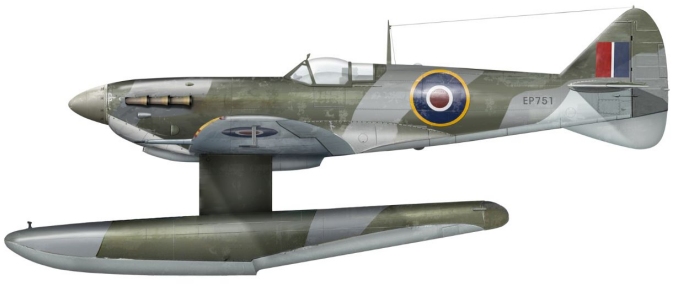During the Second World War the idea to fit Spitfires with floats was considered a number of times. In total five aircraft were converted to floatplanes, however, none would enter operational service. Find out why this idea
was considered and what happened to the five Spitfires that were converted.
The concept of a Spitfire floatplane was formulated after Norway was invaded by Germany in April 1940. The idea was that the aircraft would operate from fjords in Norway. Spitfire Mk I (R6772) was
the aircraft chosen for conversion and fitted with floats which were used on the Blackburn Roc and a ventral fin added. With the surrender of Norway and trials of the new aircraft proving
disappointing, the concept was not taken any further and (R6772) was restored to its original landplane configuration. Seeing combat in the Battle of Britain
with No. 222 Squadron, the aircraft was shot down on the 18th September 1940 with the pilot, Sergeant Ian Hutchinson, bailing out and surviving.
Top Speed
324 mph
Range
326 miles
Service Ceiling
33,400 ft
Armament
two 20mm cannons
four 0.303-in machine-guns
With the British Government's declaration of war against Japan on the 8th December 1941 early 1942 saw the idea of a Spitfire floatplane reconsidered. This time Folland Aircraft were tasked with
the job and would convert Spitfire Mk VB (W3760). Fitted with a 1,100-hp Rolls-Royce Merlin 45 and a four blade propeller instead of the landplane Spitfire Mk VBs three bladed propeller. This gave the
aircraft a top speed of 324 mph, a range of 326 miles and a service ceiling of 33,400 ft. Armament was the same as a standard landplane Spitfire Mk VB, two 20mm cannons and four 0.303-in machine-guns.
The design of the Spitfire Mk VB floatplane was similar to the earlier converted Spitfire Mk I, but it also had a parachute fitted to help recover from a spin. The big change on this prototype was instead of
fitting floats from another aircraft Arthur Shirvall designed custom floats, 25ft by 7in, for the aircraft. It had been Arthur who had designed the floats for Supermarine's Schneider Trophy
entries.
The prototype made its first flight on the 12th October 1942 with Jeffrey Quill at the controls. After further trials the decision was taken to convert a further two Spitfire Mk VBs (EP751) and
(EP754). Folland Aircraft were again tasked with the job. With three Spitfire Mk VBs converted to floatplanes, the plan was for the aircraft to be based around the Dodecanese which consisted of 15 large
and 150 small Greek islands in the South West Aegean Sea and intercept German transports flying over the Eastern Mediterranean. This would see the aircraft shipped to Egypt during October 1943.
The following month though saw the British held Kos and Leros Islands, part of the Dodecanese islands, captured by the Germans and the three aircraft stayed in Egypt. Two of the three Spitfire
floatplanes were struck off charge with (W3760) on the 28th January 1944 and (EP751) on the 28th December 1944, with the fate of (EP754) unknown.

Supermarine Spitfire Mk VB (EP751) floatplane.
Top Speed
377 mph
Range
460 miles
Service Ceiling
38,000 ft
Armament
two 20mm cannons
four 0.303-in machine-guns
Folland Aircraft would also convert the last of five Spitfires to be used as a floatplane. This time it was Spitfire Mk IX (MJ892) which was to be used in the Pacific theatre of war. Powered by a 1,720-hp
Rolls-Royce Merlin it would become the fastest floatplane of the Second World War (1939 - 1945) with its top speed of 377
mph. Its range was 460 miles and service ceiling was 38,000 ft. The armament for the Spitfire Mk IX would be the same as the Spitfire Mk VB version, two 20mm cannons and four 0.303-in machine-guns.
The 18th June 1944 saw this version make its maiden flight.
Like the previous Spitfire floatplane projects this would never enter service, and the idea was finally shelved, with (MJ892) struck off charge on the 22nd November 1945.

